This article is written by Dipanwita Ray.
The defect in a garment is not intended. But somehow, defects are generated during the processing of the garment. To make a quality garment, all the defects must be rectified through the checking process. Further action is taken to eliminate garment defects from the process and from the raw materials or avoid using the defective raw materials. By knowing the defects that may arise at each stage of garment manufacturing, it can help in taking appropriate control measures to ensure the production of the right quality of the garment.

In this post, Dipanwita Roy listed 100-plus different garment defects that are commonly found in a finished garment. First, we will classify garment defects and then will go through the list of defects and images.

In this post, Dipanwita Roy listed 100-plus different garment defects that are commonly found in a finished garment. First, we will classify garment defects and then will go through the list of defects and images.
What is a garment defect?
Quality check in the garment industry is done right from the initial stages of sourcing raw materials- fabric and trims to the stage of the finished garment and packing. Quality of the product is required to establish the brand name and build the garment exporter’s reputation, which in turn is related to consumer confidence, high sales, and exports.Classification of garment defects
It is important to understand different garment defects, defect types and source of the defect. Read the garment defects classification. Here defects name and images are shown defect category wise.1. Defect Classification Based on Severity of the Defect
Based on the severity of the defect, garment defects are classified as critical, major and minor defects.
1.1. Critical Defects
A defect that poses a safety hazard to the consumer and/ or violates mandatory regulations is termed as a critical defect. Typically, if a critical defect is found in the shipment, the importer tends to reject the entire order. This is because, a critical defect could harm the consumer, impair the image of distributors throughout the supply chain, makes the brand liable, and incurs unnecessary expenses in the event of a product recall. Some examples of critical defects in garments are:
These defects are those which result in overall product failure or reduced usability of the product that prevents it from being placed on the market. They do not pose any safety threat to the user, but typically lowers the value of the product, adversely affects its marketability and saleability, shortening the life cycle of the product, and increases product returns for replacement or refund.
Some examples of major defects in garments -
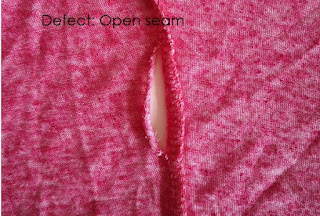

1.3. Minor Defect
Minor defects are unlikely to reduce product usability. They are workmanship defects beyond the defined specifications or construction requirements that the importer and supplier have agreed upon. Some examples of minor defects in garments are:
19. Misprinting of the label on a shipping carton
20. Untrimmed threads, missing stitches or uneven stitching on a garment
21. Minor variation in shading between garment pieces
22. Variation of care label quality or content
23. Dirt material that can easily be washed off
2.1 Fabric defects/Material Defects
These defects are found in the fabric and are mostly not caused by the sewing lines. Fabric defects could be addressed at the point of fabric inspection or cutting. Fabric defects are further classified as below.
2.1.1. Due to fabric construction (weave or knit)
24. Barre, Striation
25. Bowing or Skewing
26. Broken or missing warp/ weft yarn (Broken end)
27. Cuts & Tears
28. Drop stitch, Laddering
29. A fabric with the wrong specification
30. Foreign Particles
31. Hole
32. Knot or Repair
33. Nap or Pile Deformation
34. Pills formation
35. Reed marks
36. Thick and thin places
37. Uneven knitting
For more images of fabric defects, refer to the article fabric defect classification.


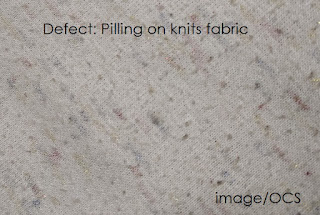
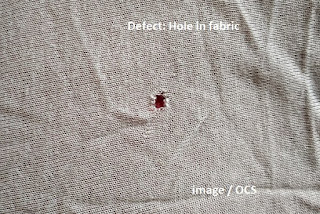

2.1.2. Colour and Print
38. Dyeing spot
39. Metamerism (store light vs daylight)
40. Mismatching of Panel, Interlinings
41. Misprint fabric or Printing defects
42. Shade Difference
43. Colour fastness (Staining)
44. Streaky appearance
45. Colour-off standard
46. Dye bars
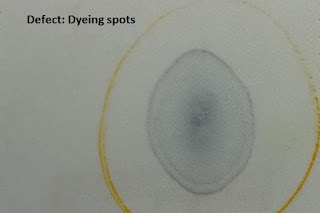


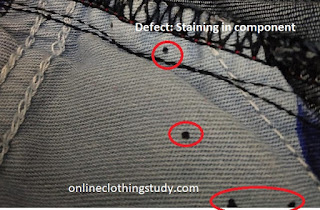
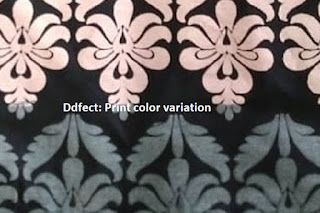
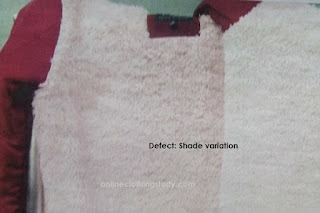
2.1.3. Fabric Appearance, General
47. Burn or Scorch Marks
48. Delamination of fusible
49. Fabric hand feel differs from the approved sample
50. Marks, stains, dirt, oil stains
51. Washing Marks, Fold Lines
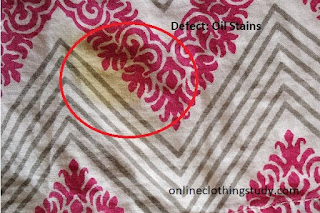

(1) Presence of a needle or other sharp object included in the packaging of the finished good due to the cutting and sewing processes involved in the manufacturing of the garment.
(2) Blood stains on the garment due to the presence of a sharp object which might pierce a worker accidentally during work.
(3) Broken button
(4) Mould on a garment
(5) Improperly secured loose trims and fasteners
(6) Drawstring near head or neck in infant and kids wear
(7) Thread or trims which are extensively long or loose
(8) Missing suffocation warning labels
1.2. Major Defect
Some examples of major defects in garments -
9. Open seams
10. Holes
11. Broken stitches,
12. Incorrect colours or designs on the product,
13. Damaged fabric,
14. Bubbling due to fusing,
15. Zipper,
16. Button not well attached,
17. Incorrect SPI,
18. Main label spot etc.


1.3. Minor Defect
Minor defects are unlikely to reduce product usability. They are workmanship defects beyond the defined specifications or construction requirements that the importer and supplier have agreed upon. Some examples of minor defects in garments are:
19. Misprinting of the label on a shipping carton
20. Untrimmed threads, missing stitches or uneven stitching on a garment
21. Minor variation in shading between garment pieces
22. Variation of care label quality or content
23. Dirt material that can easily be washed off
2.1 Fabric defects/Material Defects
These defects are found in the fabric and are mostly not caused by the sewing lines. Fabric defects could be addressed at the point of fabric inspection or cutting. Fabric defects are further classified as below.
2.1.1. Due to fabric construction (weave or knit)
24. Barre, Striation
25. Bowing or Skewing
26. Broken or missing warp/ weft yarn (Broken end)
27. Cuts & Tears
28. Drop stitch, Laddering
29. A fabric with the wrong specification
30. Foreign Particles
31. Hole
32. Knot or Repair
33. Nap or Pile Deformation
34. Pills formation
35. Reed marks
36. Thick and thin places
37. Uneven knitting
For more images of fabric defects, refer to the article fabric defect classification.





2.1.2. Colour and Print
38. Dyeing spot
39. Metamerism (store light vs daylight)
40. Mismatching of Panel, Interlinings
41. Misprint fabric or Printing defects
42. Shade Difference
43. Colour fastness (Staining)
44. Streaky appearance
45. Colour-off standard
46. Dye bars






2.1.3. Fabric Appearance, General
47. Burn or Scorch Marks
48. Delamination of fusible
49. Fabric hand feel differs from the approved sample
50. Marks, stains, dirt, oil stains
51. Washing Marks, Fold Lines


2.2. Workmanship and Handling defects in garments
These are defects that are caused during the manufacture of the garment. The stages of garment manufacturing- pattern making, spreading, cutting, sewing, assembling, finishing, and packaging involve a lot of workmanship and material handling.2.2.1. Pattern Making
Pattern making related to garment defects include -
52. A difference in measurement of a garment part from others
53. Missing pattern parts
54. Pattern not aligned with respect to fabric grain
55. Patterns not facing in the correct direction on napped fabrics
56. Poor line definition leading to inaccurate cutting
57. Skimpy marking
58. Wrong Check Boxing
59. Wrong Gradation of Sizes
2.2.2. Spreading and Cutting
Garment defects caused by spreading and cutting process
60. Drill and Notches Marks
61. Frayed Edges
62. Garment part damaged by careless use of a knife
63. Improper Knife Cut
64. Inaccurate Cutting
65. Incorrect Tension of Plies
66. Narrow Fabric
67. Not all Plies Facing in Correct Direction
68. Notches misplaced, Too deep, Too shallow, Angled, Omitted
69. Plies misaligned
70. Scorched or fused edges
71. Slits opened inaccurately or Omitted
2.2.3. Garment defects generated in the stitching process
72. Bartack missing73. Blind stitch visible
74. Bow or motif poorly positioned, loosely attached
75. Broken stitches
76. Button attached loosely
77. Button-hole is untidy or fraying
78. Button stitching is too tight preventing functionality
79. Button or buttonhole not aligned properly
80. Collars misshaped, unbalanced, bubbled
81. Excess fabric on stitch
82. Finished components not symmetrical
83. Finished garments not to size
84. Frayed edges (overlock missing)
85. Improper bottom hemming
86. Improper positioning of the belt loop (slanted)
87. Incorrect pocket position
88. Insecure back stitching
89. Lining too full or too tight
90. Lining/ Padding exposed
91. Mismatch checks, plaids, or stripes
92. Needle cut
93. Needle marks
94. Oil stain
95. Open stitch
96. Over stitching
97. Parts, components, closures omitted or damaged
98. Pleat on seam
99. Ropy hem
100. Run of stitch
101. Seam pucker
102. Seam grinning
103. Seam is open
104. Seam mismatch
105. Seam not secured
106. Seam slippage
107. Seam unravelling
108. Skipped stitches
109. SPI incorrect, irregular
110. Thread breaks
111. Thread tension high
112. Thread tension low
113. Torque on the side seam

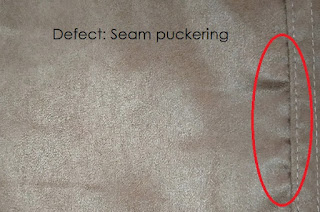













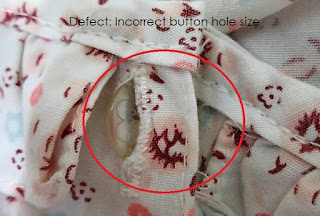




2.2.4. Garment defects caused in the Finishing and Washing process
114. After wash streak or striation
115. Back staining of pocket
116. Care label fading/ damage after wash
117. Chalk, pen, or pencil marks visible
118. Untrimmed threads
119. Garment torque or spirality



2.2.5. Garment defects caused in pressing
120. Appearance not smooth
121. Scorching or burn marks
122. Water spots not dried


2.2.6. Packing related garment defects
123. Incorrect folding/ packing
124. Labels not showing where required
125. Omitted warning signs in the polybag
126. Smeared barcodes or instructions
127. Wrong size, colour, and quantity packed
2.3. Garment defects from defective Trims and Accessories
2.3.1. TrimsCommonly found defects related to trims
128. Brass zipper, buttons, rivets leaving stains on the product due to oxidation
129. Button loops inconsistent or irregular
130. Button missing or damaged button
131. Button size not matching with button hole
132. Care label missing
133. Embroidery backing excessive
134. Embroidery needle cuts
135. Embroidery, applique poorly positioned, untidy or unfinished
136. Fasteners poorly positioned, missing, or malfunctioning
137. Lace irregular shape or untrimmed
138. Missing collar bone
139. Poor elasticity of elastic
140. Spare button missing
141. Zipper malfunction
142. Zipper puller self-lock not secure
143. Zipper tape shortage
144. Zipper wavy
145. Main label spot or damaged
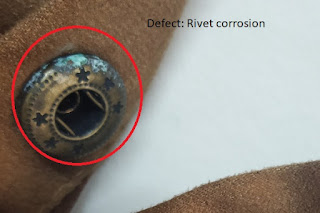

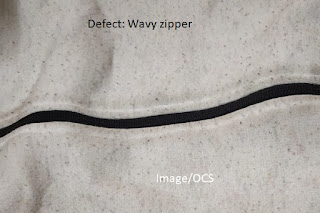
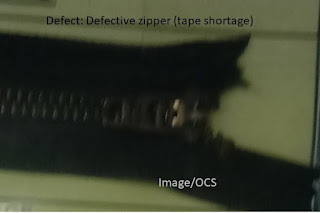


2.3.2. Accessories
146. Missing or wrong placement or incorrect carton stickers
147. Missing/ wrong placement/ incorrect hangtags (hangtag off shade)
148. Broken hanger resulting in sharp end/ edge
In this post, you saw a 100 plus different of defects found in a garment. Note, garment defects are not limited to this list. There are many other kinds of defects you may find when you will checking a finished garment. Check a similar list of garment defects for a trouser.
References:
https://www.intouch-quality.com/blog/how-to-classify-defects-for-garment-inspection
https://www.fibre2fashion.com/industry-article/3092/defects-in-garments?page=5
https://www.adidas-group.com/en/sustainability/products/product-and-consumer-safety/
http://www.intertek.com/textiles/inspection/
http://www.sdfltd.com/critical-defects-for-a-garment.html
http://garmentstech.com/inspection-defect-checklist-for-garment-workmanship-and-appearance/garment-workmanship-and-appearance/
Hashi, M. R., 2016. Different Types of Defects Identification and Controlling Method for Quality and Productivity Improvement. IOSR Journal of Polymer and Textile Engineering, 3(2), pp. 01-18.
About the author: Dipanwita Ray is a graduate in Fibres and Textile Processing Technology, and is currently pursuing her master's degree in Fashion Technology from NIFT, New Delhi. She is interested in textile chemistry, functional garments, and apparel supply chain.
